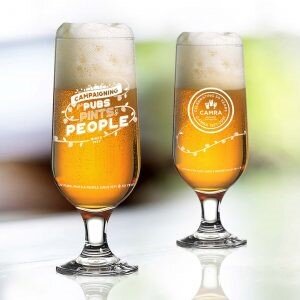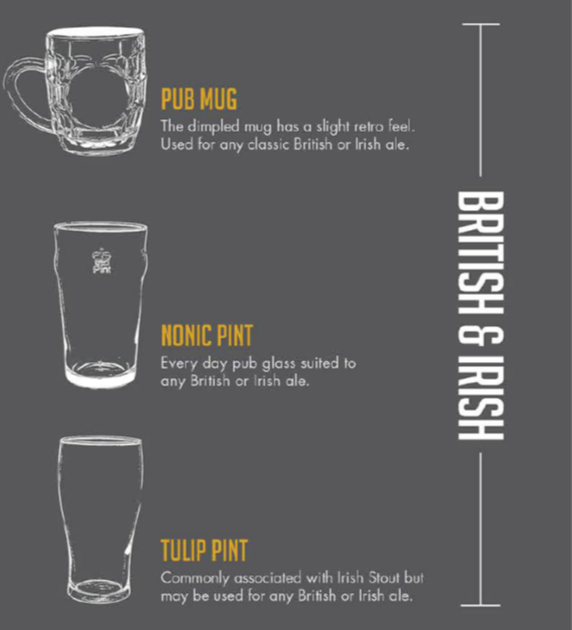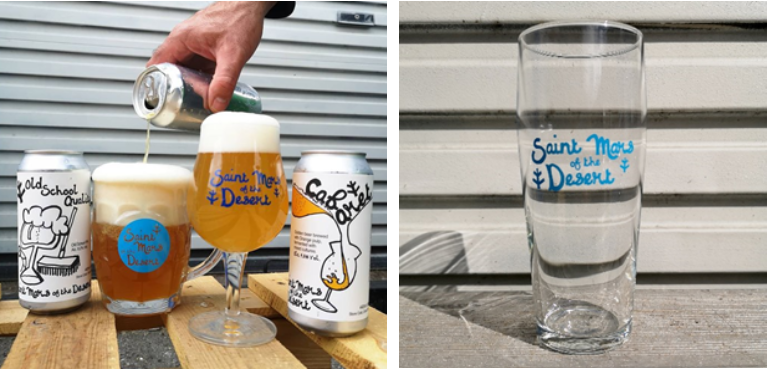A pint of cask Bitter in a nonic is the first thing that pops up in my head when I think of British beer. Yet this image doesn’t align with their beer culture these days as neither the beer style nor glass are particularly popular. While it might be easy to lament their decline, especially for Bitter, the British beer scene is incredibly vibrant right now. This will be explored in detail in Matthew Curtis’ forthcoming book, Modern British Beer.
A recently announced promotion for the book caught my attention due to the glass it included. It’s essentially a stemmed Pilsner glass. According to the Campaign for Real Ale (CAMRA), publishers of the book, “it is a glass that’s accessible for a wide range of beer drinkers.”
A tasting glass sold with a special offer from CAMRA for the book. Image source: CAMRA.
CAMRA has made great progress lately in promoting tradition while recognizing the need to incorporate contemporary trends. It’s the organization’s traditional component that had me assume they advocate for the use of dimple mugs and nonics, perhaps even the tulip glass often associated with Guinness. These are the glasses that Cicerone identifies in its glassware guide as British and Irish glassware styles. However, they are not commonplace in contemporary use, and neither are the styles of beer traditionally associated with those glasses (with the exception of the beers from Guinness).
From Cicerone’s Guide to Beer Glassware. The depiction is not quite consistent with modern British beer drinking culture.
Some changes were taking place in the pre-modern British beer era that impacted the glassware styles that were/are used. Before the craft beer revolution took hold of England, the growth of lager sales had been the most notable change to the domestic beer culture. This is now the overwhelming majority of beer consumed in the country. It’s growth brought different drinking vessels. Around the same time (and perhaps because of this, at least in part), glassware manufacturers in the country known for making some of the iconic domestic beer glass styles were closing down.
Since its inception, part of CAMRA’s mission has been to promote the proper serving of real ale. To them, a specific glass style isn’t crucial to enjoying a good pint. Accordingly, the organization generally doesn’t advocate for a particular shape.
CAMRA celebrates its 50th anniversary this year. In honor of the occasion, it released a commemorative glass. Its shape is the one that’s most common these days. The straight glass (aka straight-sided, conical, or shaker pint) is ubiquitous in the United Kingdom. Despite the negative connotation it has here in the US craft beer scene, it’s generally embraced in the UK.
The straight glass is not new to UK beer drinkers. Beer writer Martyn Cornell identifies its use going back at least as far as the 1920s and 30s when it was referred to as a tumbler. Countless breweries have used it over the years, including Adnams, Batemans, Black Sheep, Fuller’s and Marston’s. A wealth of younger ones like Southwark, Verdant and Deya use them as well. However, this younger generation of breweries will often have more elegant glassware offerings as well.
Given its ubiquity and general embrace, it’s not surprising then that the glass image on the cover of Curtis’ book is the straight glass. It’s the “great leveler”, according to him. Versatile and inclusive. CAMRA’s Alex Metcalfe notes a similar sentiment, stating “the cover is an homage to the diversity and inclusion in the modern British beer scene.” As far as the book’s contents, he notes “for the most part, the container is not the central issue for us. Sensory experience, good company and exploring modern British beer culture are all at the core of Modern British Beer.”
Curtis explains it’s important to keep beer accessible and to suggest a particular glass must be used for a certain beer, potentially forcing consumers to spend more to enjoy it, can contribute to gatekeeping. While consumers don’t need to use a straight glass to feel that they’re egalitarian, those that do not have a selection of Teku’s to enjoy their hazy IPA should not be disenfranchised either.
To CAMRA, the straight glass imagery on the cover is important, as Metcalfe puts it, because it “is a kind of universal emblem that’s recognisable from many beer drinking contexts, locations, and cultures. Considering the transatlantic exchange of influences within beer culture and brewing over the last 50 years it is particularly relevant to the themes explored within Modern British Beer.” He adds “it is a definitive move away from the tankard in that the associations with a tankard are perhaps heavily weighted - this is a light touch approach from us, indicative of a wider feeling that it really it is up to the reader to choose their glassware.”
Sheffield brewery Saint Mars of the Desert is a wonderful representation of the modern British beer scene. The primary vessel they use to serve their beer is a stemmed tulip-like glass. They also use a Willi Becher and a dimple mug. This is a fitting, well-rounded selection. That said, brewer and owner Dann Paquette says that if he goes out to a pub and orders a pint of Bitter, he’s “hoping for the nonic glass or the old man dimple mug.”
Saint Mars of the Desert’s glassware selection strikes a perfect balance to serve patrons their varying styles of beer. Image source: Saint Mars of the Desert.
For Five Points Brewing Company in London, glassware is an “advertiser and an amplifier”, as Ed Davy from the brewery notes. It’s no secret that glassware offers a wonderful opportunity to advertise a brand. He elaborates, “in its simplest form, this just puts a logo in the customer’s hand; at its most advanced, I’ve seen breweries put QR codes on their glasses that link to tasting notes, promotional giveaways or an info-page about the brewery. Branded glassware is one of the most immediate and direct ways of establishing a relationship with the customer and informing them about the beer they’re drinking.”
Regarding amplification, Davy says “well-designed glass can improve the drinking experience by intensifying existing elements of the drink.” While different styles of glassware can amplify in different ways, he adds “you can create feelings of nostalgia by serving cask ale in ‘traditional’ dimpled jugs”, and this is something the brewery does at its taproom for its cask beer. To be most efficient with space at their pub, The Pembury Tavern, the straight glass is used. For kegged beer, they use a Willi Becher.
London’s Five Points Brewing Company is known for being a contemporary brewery keeping many of the traditional British beer styles alive. This doesn’t prevent them from making use of a variety of glassware styles. Image sources: Five Points Brewing Company.
Metcalfe mentions he understands that for some, the dimple mug is “prime Instagram fodder”. He suspects this may be because “it’s mostly the exception to the rule and now a nostalgic novelty.” That said, anyone paying attention to Five Points’ social media accounts will likely attest to how the brewery has been able to successfully leverage this nostalgia with the mug.
A tulip glass would be ideal for Davy in an everyday pub, but he’s not too picky, as long as it’s clean. However, things are different in his local pub. “All that goes out the window. I don’t care about the glass style, I don’t even want glass - I want my pewter tankard, which lives behind the bar.” Talk about nostalgia.
Curtis is a bit like me when it comes to glassware. Ambivalent about what others do, but a little picky with personal consumption. Also like me, he gravitates toward the Willi Becher.
Despite romantic notions of older glassware styles that people like myself may have, British beer drinkers have moved on to other vessels. And that’s probably a good thing. If I’m being honest, glasses like the nonic and dimple aren’t great. The craft beer scene in England is thriving and dynamic, and the glassware that’s accompanying it has changed for the better.
CAMRA will be launching a new online beer style resource soon. Examples were photographed by Nicci Peet in a mix of contemporary and traditional glassware. Keep an eye out for that, as well as Curtis’ book, which is being released on August 12th. Those in the United States can order the book through Waterstones. It’s highly recommended. I will be doing a write-up on it for PorchDrinking.com.
Note: for further reading on the history of beer drinkware in England, I suggest the above referred to Zythophile blog post ‘More notes towards a history of the beer mug’ and the book Pub Beer Mugs and Glasses by Hugh Rock. Also, if you’re interested in the history of the nonic, a glass with US origins, see a prior post here.







